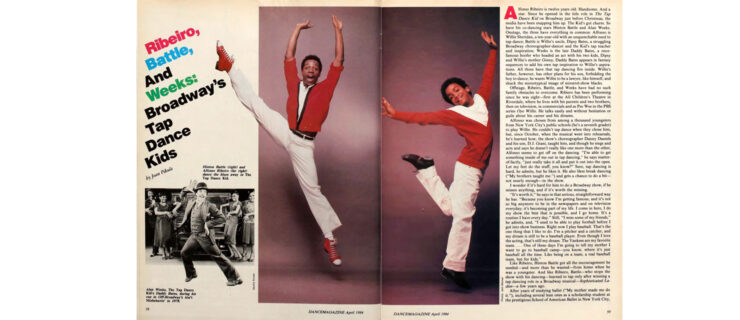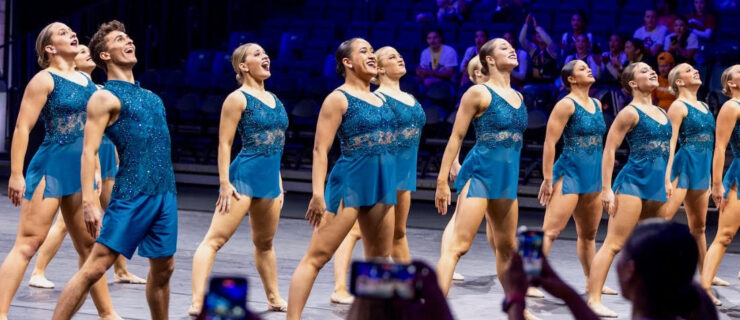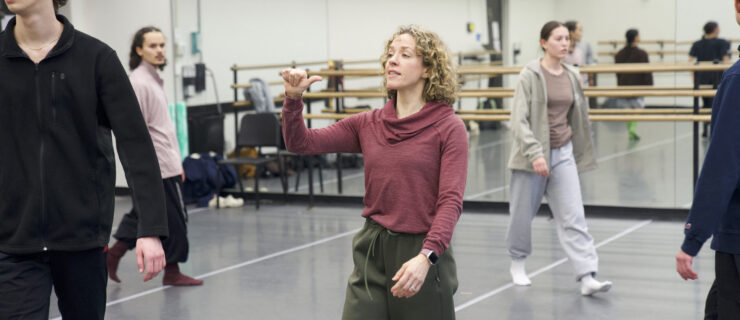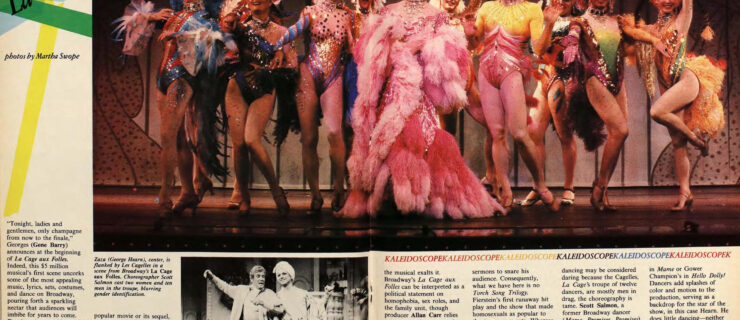The Hurt Factor
Andrea Dawn Shelley navigates the controlled adagio of Spencer Gavin Hering’s new work Ash with steady precision and understated femininity. No one would know she’s struggled with knee pain most of her dancing life. Shelley, a former dancer with Dominic Walsh Dance Theater and co-founder of iMEE, a dance company in Santa Barbara, California, has been dancing with pain since the age of 14, when her knee cap dislocated coming out of a pirouette. Four knee surgeries later, Shelley finds she’s in as much pain during rest or slow rehearsal days as when she’s dancing.

Dancers know that pain comes with the profession. Each body is unique, and so is the discomfort that it can generate. Pain that lasts over three months earns the “chronic” label. It has a different character and different causes than acute pain, which comes from sudden injury or the post-surgical healing process. The fact that pain is an invisible aliment further complicates the situation. Dancers can be torn between fears of time off and a life lived in discomfort. Yet no dancer blindly accepts pain as a constant. Think of it more as a problem to be solved—and solved before pain patterns settle in. Aggressive research of pain’s origins, coupled with physical therapy, advances in surgery, and alternative treatment methods, have helped dancers break out of the pain cycle.
Know your pain
Diagnosis plays a key role. Chronic pain need not be inevitable, says Dr. Peter Lavine, an orthopedist who treats dancers in Washington, DC. He recommends rigorously sleuthing your pain’s source. “Pain doesn’t sneak up on you,” he says. “Usually it’s related to an injury you are extremely familiar with.” Dancers often accept an initial diagnosis without investigating further. “Never hesitate to get a second opinion,” says Lavine. “Sometimes you need a new set of eyes on the problem.” Understanding pain’s root makes a difference in the entire approach to treatment. For instance, Lavine makes a distinction between neurological pain, where damage to nerves is involved, and degenerative pain, a by-product of overuse injuries or inflammatory conditions like arthritis. “An epidural could help neurological pain, while it’s not effective for problems like arthritis,” he says.

Getting to the bottom of your pain profile involves a thorough physical exam. Sometimes pain traces back to a condition that has little relation to dance. Your primary care doctor can rule out sources of spasm such as ovarian cysts or irritable bowel syndrome. “Food allergies can be a culprit,” says physical therapist Marika Molnar, who treats New York City Ballet dancers. “Lyme disease is another one that is frequently missed.”
Dancers tend to avoid any kind of treatment that might take them off-stage even for a short period. New York City Ballet principal Joaquin De Luz danced with knee pain for nearly two years. Finally tests revealed a serious tracking problem in his knee. “Adrenalin is a powerful drug,” says De Luz. “When the spotlights come on, you go out there and think you can overcome injuries.” After researching the best knee surgeons in the country, De Luz opted for surgery. After four months, he was back dancing pain-free.
Habit and help
Sometimes pain stems from something as treatable as how you are working. Molnar has seen many a pain problem resolved by looking more closely at a dancer’s technique. Change the habit and pain levels can change as well. “It’s possible to learn how to do things with the body in a way that changes the message to the brain,” says Molnar. (See sidebar.)
Even when technique doesn’t seem the culprit, alternative somatic practices like the Feldenkrais Method can yield real benefits. This uses gentle movement sequences that explore the brain-body connection and gradually alters habits that may be contributing to pain. Shelley investigated Feldenkrais early on in her professional career when she first began having pain. “While it didn’t make the pain go away,” she says, “it opened my mind to how relaxation is a factor in reducing it.”
Molnar has seen dancers benefit from less familiar alternative approaches, like skin rolling, also known as myofascial release, which is like massage. In this hands-on technique, the skin is lifted, stretched and squeezed. Because of the amount of nerve endings in the skin, practitioners say this permits new information to flow through the nervous system. “Lifting the skin can send a different message to the brain,” says Molnar, “and cut in between the pain.”
The emotional cycle of pain
There’s a longstanding debate about pain’s mental aspects. What can’t be seen is in your head, right? Yes and no. A dancer might feel more discomfort than the diagnosis indicates. Pain signals play out differently in each person. “What we tell ourselves about the extent of our pain can influence the amount that we feel it,” says Rachel Winer, Ph.D, a Houston psychologist and former dancer in private practice. “Pain can be facilitated or inhibited by attention, memory, and emotion.”
Unfortunately, Shelley eventually came to equate dance with pain. “I remember the day I realized pain was separate from dance,” she says. “I had assumed that everyone was in pain.” For Shelley, pain has been more about resolve than resolution. She takes a disciplined approach to managing it. Shelley found that aggressively icing sore limbs, occasional pain medication and a rigorous approach to warming up made dancing doable. So did taking hold of her artistic life. After several years with Houston’s Dominic Walsh and other companies like Miami’s Maximum Dance Company, Shelley wanted more control. She and her partner Spencer Gavin Hering recently started iMEE Dance Company. As co-artistic director, she decides what movement she can—and can’t—do. “I know my limitations,” she says. ”I don’t need to go over a new phrase repeatedly, and I can stay away from movements that cause me trouble.”
At peace with pain
While few dancers manage a pain-free career, they can have more control over pain than they realize. “Dancers need to become good pain discriminators,” says Winer. “There’s a big difference between good pain from learning a new movement and the kind that doesn’t go away or gets worse with time.”
Many dancers act as though ignoring pain were a way to make it disappear. But pain is the body speaking directly to the brain. Though many dancers shy away from medication, thinking it can make them fuzzy, Dr. Peter Lavine finds traditional anti-inflammatories a good place for dancers to start. And for nerve pain, “Ultram and Lyrica have been shown to be helpful and are non-narcotic,” he says.
Lavine, Winer, and Molnar all agree that, in most cases, moving (correctly) improves chronic pain. “It’s essential to life and pain reduction,” Molnar insists. “Movement circulates the blood and gets your body working again. Dancing is good medicine.” De Luz remembers his first pain-free plié post surgery. “My knee felt rusty, but it was amazing,” he says. Shelley maintains her resolve to stay a creative performer despite unpredictable pain. “Sometimes, I go through dark places,” she says. “I think I should quit because I have been dealing with it for so long. But then I step onstage and it’s all worth it. I am not willing to give that up. I enjoy it too much.”
Nancy Wozny is a culture and health writer in Houston.
Photo by Nathan Sayers.
Working Correctly
What you do makes a difference.
Poor technique can set a dancer up for prolonged trouble. Unless you change the pattern, the pain will remain. Ask a physical therapist to take a look at what you are doing at the barre that could be contributing to your pain. Remember that where pain feels like it occurs may not be its source. Pain often points to one place doing too much while another place is doing to little.
Marika Molnar, NYCB’s physical therapist, cites a dancer who came to physical therapy complaining of pain in the left knee at the infrapatellar junction (where the patellar tendon inserts). The pain began as intermittent, but had become constant. Molnar observed him do a series of basic movements such as demi-plié, relevé and tendus. “It was clear that he rolled in excessively on his left foot,” Molnar says. “He needed a greater awareness of the turnout of his left hip. Focusing on motor control of the hip, knee, and ankle maintains a healthy alignment and takes the stress off of the patella tendon.” The dancer felt a marked reduction in pain when he began to take a more holistic view of his body, concentrating on the connections between the foot, knee and hip joint.
To address similar problems, Molnar recommends doing 20–25 demi pliés in parallel while maintaining correct alignment. She then increases the neuromuscular challenge by having a dancer do the same movement with weight on just one leg, adding variety, complexity, and diversity to the neural system to gradually retrain the dancer’s work patterns. —NW




